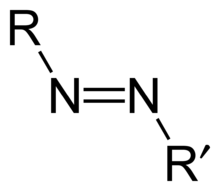Azo compound
Azo compounds are compounds bearing the functional group diazenyl R−N=N−R′, in which R and R′ can be either aryl or alkyl.

IUPAC defines azo compounds as: "Derivatives of diazene (diimide), HN=NH, wherein both hydrogens are substituted by hydrocarbyl groups, e.g. PhN=NPh azobenzene or diphenyldiazene."[1] The more stable derivatives contain two aryl groups. The N=N group is called an azo group. The name azo comes from azote, the French name for nitrogen that is derived from the Greek ἀ- (a-, "not") + ζωή (zōē, life).
Many textile and leather articles are dyed with azo dyes and pigments.[2]
Aryl azo compounds
Aryl azo compounds are usually stable, crystalline species. Azobenzene is the prototypical aromatic azo compound. It exists mainly as the trans isomer, but upon illumination, converts to the cis isomer.

Aromatic azo compounds can be synthesized by azo coupling, which entails an electrophilic substitution reaction where an aryl diazonium cation is attacked by another aryl ring, especially those substituted with electron-donating groups:[4]
- ArN+
2 + Ar′H → ArN=NAr′ + H+
Since diazonium salts are often unstable near room temperature, the azo coupling reactions are typically conducted near 0 °C. The oxidation of hydrazines (R−NH−NH−R′) also gives azo compounds.[5] Azo dyes are also prepared by the condensation of nitroaromatics with anilines followed by reduction of the resulting azoxy intermediate:
- ArNO2 + Ar′NH2 → ArN(O)=NAr′ + H2O
- ArN(O)=NAr′ + C6H12O6 → ArN=NAr′ + C6H10O6 + H2O
For textile dying, a typical nitro coupling partner would be disodium 4,4′-dinitrostilbene-2,2′-disulfonate. Typical aniline partners are shown below.[6]

As a consequence of п-delocalization, aryl azo compounds have vivid colors, especially reds, oranges, and yellows. Therefore, they are used as dyes, and are commonly known as azo dyes, an example of which is Disperse Orange 1. Some azo compounds, e.g., methyl orange, are used as acid-base indicators due to the different colors of their acid and salt forms. Most DVD-R/+R and some CD-R discs use blue azo dye as the recording layer. The commercial success of azo dyes motivated the development of azo compounds in general.
Alkyl azo compounds
Aliphatic azo compounds (R and/or R′ = aliphatic) are less commonly encountered than the aryl azo compounds. A commercially important alkyl azo compound is azobisisobutyronitrile (AIBN), which is widely used as an initiator in free-radical polymerizations and other radical-induced reactions. It achieves this initiation by decomposition, eliminating a molecule of nitrogen gas to form two 2-cyanoprop-2-yl radicals:
For instance a mixture of styrene and maleic anhydride in toluene will react if heated, forming the copolymer upon addition of AIBN.
A simple dialkyl diazo compound is diethyldiazene, EtN=NEt.[7] Because of their instability, aliphatic azo compounds pose the risk of explosion.
AIBN is produced by converting acetone cyanohydrin to the hydrazine derivative followed by oxidation:[8]
- 2 (CH3)2C(CN)OH + N2H4 → [(CH3)2C(CN)]2N2H2 + 2 H2O
- [(CH3)2C(CN)]2N2H2 + Cl2 → [(CH3)2C(CN)]2N2 + 2 HCl
Safety and regulation
Many azo pigments are non-toxic, although some, such as dinitroaniline orange, ortho-nitroaniline orange, or pigment orange 1, 2, and 5 have been found to be mutagenic.[9] Likewise, several case studies have linked azo pigments with basal cell carcinoma.[10]
European regulation
Certain azo dyes can break down under reductive conditions to release any of a group of defined aromatic amines. Consumer goods which contain listed aromatic amines originating from azo dyes were prohibited from manufacture and sale in European Union countries in September 2003. As only a small number of dyes contained an equally small number of amines, relatively few products were affected.[2]
See also
- Azo coupling
References
- IUPAC, Compendium of Chemical Terminology, 2nd ed. (the "Gold Book") (1997). Online corrected version: (2006–) "azo compounds". doi:10.1351/goldbook.A00560
- European Ban on Certain Azo Dyes Archived 2012-08-13 at the Wayback Machine, Dr. A. Püntener and Dr. C. Page, Quality and Environment, TFL
- Kazem-Rostami, Masoud; Moghanian, Amirhossein (2017). "Hunlich base derivatives as photo-responsive Ʌ-shaped hinges". Organic Chemistry Frontiers. 4 (2): 224–228. doi:10.1039/C6QO00653A.
- H. T. Clarke; W. R. Kirner (1941). "Methyl Red". Organic Syntheses.; Collective Volume, 1, p. 374
- March, J. (1992). Advanced Organic Chemistry (5th ed.). New York: J. Wiley and Sons. ISBN 978-0-471-60180-7.
- Klaus Hunger, Peter Mischke, Wolfgang Rieper, Roderich Raue, Klaus Kunde, Aloys Engel: "Azo Dyes" in Ullmann’s Encyclopedia of Industrial Chemistry, 2005, Wiley-VCH, Weinheim.doi:10.1002/14356007.a03_245.
- Ohme, R.; Preuschhof, H.; Heyne, H.-U. (1988). "Azoethane". Organic Syntheses.; Collective Volume, 6, p. 78
- Jean-Pierre Schirmann, Paul Bourdauducq: "Hydrazine" in Ullmann's Encyclopedia of Industrial Chemistry, Wiley-VCH, Weinheim, 2002. doi:10.1002/14356007.a13_177.
- Tucson University. "Health & Safety in the Arts, A Searchable Database of Health & Safety Information for Artists". Tucson University Studies. Archived from the original on 2009-05-10.
- Eva Engel; Heidi Ulrich; Rudolf Vasold; Burkhard König; Michael Landthaler; Rudolf Süttinger; Wolfgang Bäumler (2008). "Azo Pigments and a Basal Cell Carcinoma at the Thumb". Dermatology. 216 (1): 76–80. doi:10.1159/000109363. PMID 18032904.
